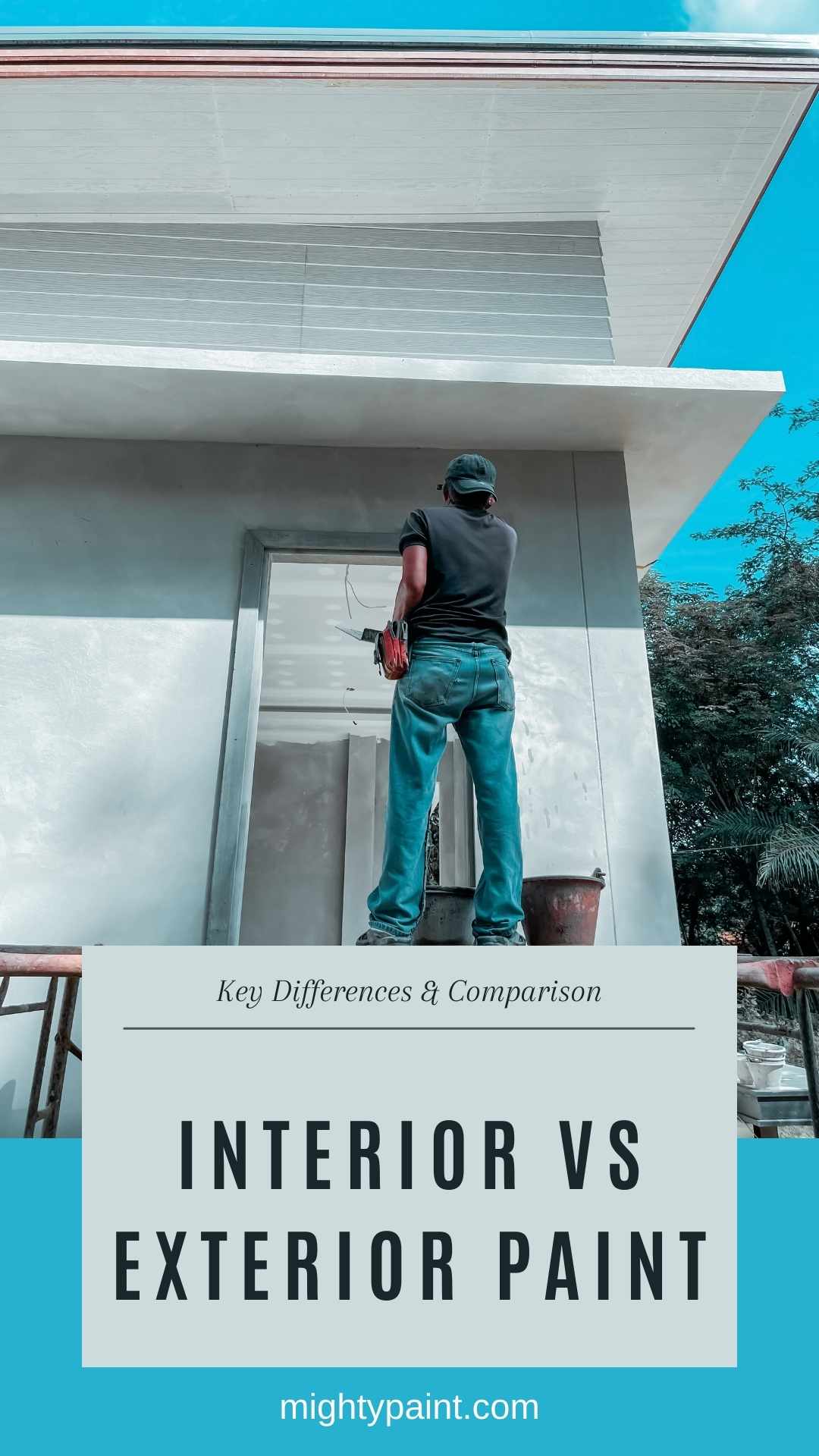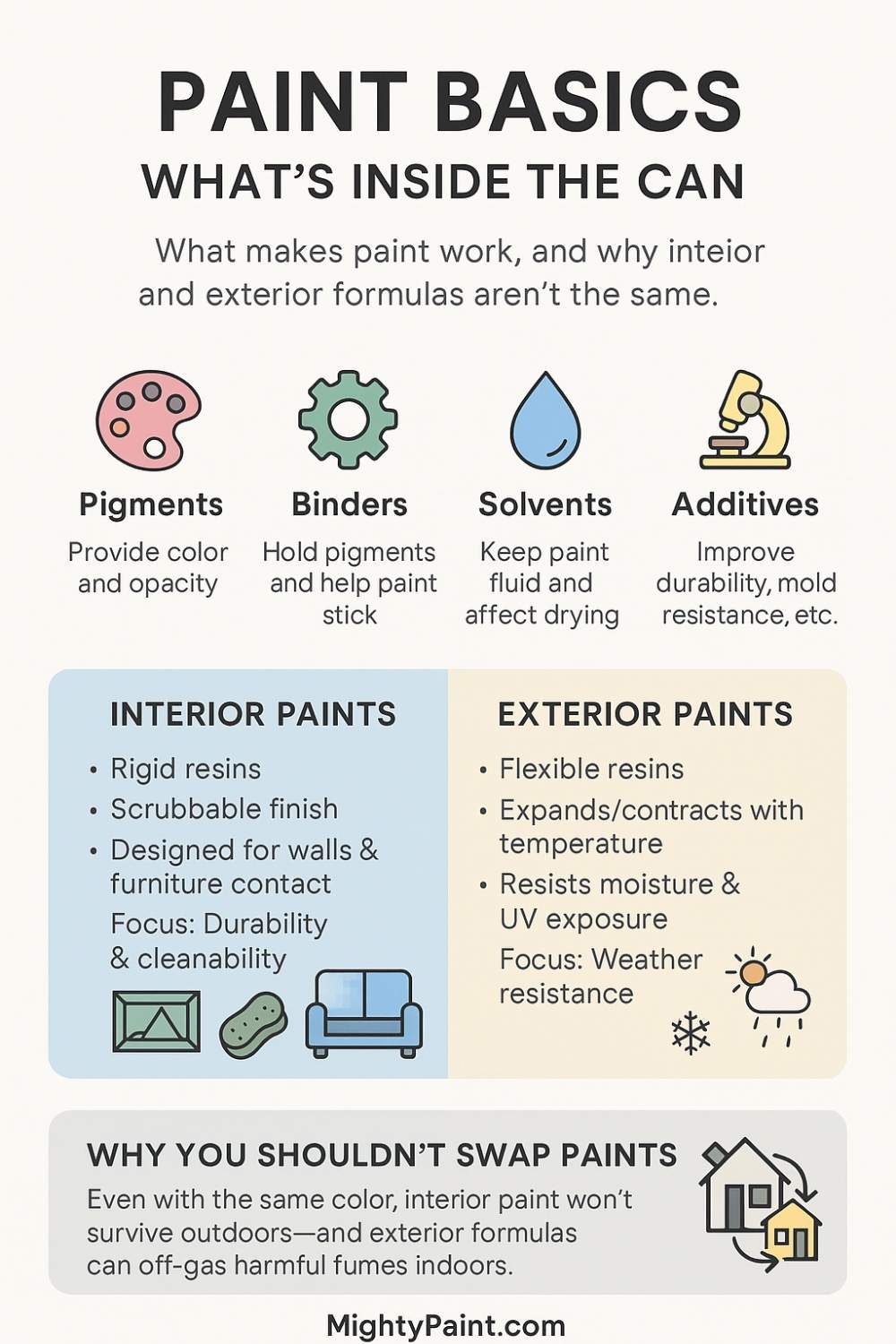Interior vs Exterior Paint: Key Differences Every Homeowner Should Know
Ever stood in the paint aisle staring at cans labeled “interior” and “exterior” and wondered—what’s the actual difference? I’ve been there too. It’s easy to assume all paint is the same, just in different packaging. But the truth? The type of paint you choose can make or break your project.

Interior and exterior paints are made for very different environments. One is built to handle scuffs, scrubbing, and cozy living rooms. The other is a warrior—battling sun, rain, and temperature swings. Use the wrong one in the wrong place, and you might end up with peeling walls, weird odors, or worse.
In this guide, I’ll walk you through everything you need to know about interior vs exterior paint—what’s inside, how they perform, and how to choose the right one for your space. Let’s clear up the confusion and make sure your next paint job is a success.
Planning a paint project? Try our free checklist tool to stay organized.
Paint Basics – What’s Inside the Can
When we talk about paint, we’re really talking about a mix of four main ingredients: pigments, binders (or resins), solvents, and additives. These components are present in both interior and exterior paints—but the ratios and types differ depending on where the paint is meant to be used.
Common Ingredients in All Paints
- Pigments provide color and opacity. Whether it’s your living room wall or a backyard fence, pigments help cover previous layers and deliver the shade you’re going for.
- Binders (resins) hold the pigment particles together and help the paint adhere to surfaces.
- Solvents make the paint workable and determine how fast it dries. Water is common in latex/acrylic paints; oil-based paints use mineral spirits.
- Additives enhance performance—things like anti-mold agents or fast-drying compounds.
At a glance, the ingredients look similar. But what really sets interior and exterior paints apart is how these ingredients are chosen and combined.
Key Differences in Resin Types
Resins (or binders) are the backbone of any paint formula—and this is where interior and exterior products start to part ways.
- Interior paints use rigid resins that create a tough, scrubbable surface. They’re designed to resist marks from furniture, fingerprints, and cleaning.
- Exterior paints rely on softer, more flexible resins that can expand and contract with temperature and moisture changes. This prevents cracking and peeling over time in outdoor conditions.
This difference means you shouldn’t swap one for the other—even if the colors match perfectly.

Additives That Define Performance
Additives are like secret ingredients that make paints smarter, stronger, and more suited to their environment. They’re responsible for everything from odor control to weather resistance.
Interior Paint Additives
Inside your home, the biggest enemies are scuffs, stains, and smudges. Interior paints include additives that:
- Improve washability and stain resistance, making them great for kitchens and kids’ rooms.
- Enhance color retention in low-UV environments (like inside a dim hallway).
- Minimize odor and emissions, especially in low-VOC or zero-VOC products.
These additives ensure a longer-lasting, easy-to-maintain finish—without turning your house into a chemical hazard.
Exterior Paint Additives
Outside, paint is exposed to a whole different battlefield: UV rays, rain, mold, and mildew.
To fight back, exterior paints include:
- UV blockers to prevent fading from sunlight.
- Mildewcides and fungicides to stop mold growth in humid or rainy climates.
- Waterproofing agents to protect surfaces like wood or brick from moisture damage.
These extras give exterior paint the power to handle seasonal abuse—something interior formulas just aren’t made to do.
VOC Levels, Safety & Environmental Impact
If you’ve ever walked into a freshly painted room and felt light-headed or dizzy, VOCs are likely to blame. VOCs, or volatile organic compounds, are chemicals that evaporate into the air as paint dries—and they’re a big deal when choosing between interior and exterior paints.
Understanding VOCs
VOCs are found in both types of paint, but the amount can vary drastically. They help with application and durability, but come with a cost: indoor air pollution, unpleasant smells, and long-term health concerns with prolonged exposure.
Health Impacts & Regulations
- Interior paints are formulated with low or zero VOCs to comply with strict indoor air quality standards. These products are safer to use around children, pets, or anyone sensitive to chemicals.
- Exterior paints often have higher VOC content because they’re built to last against harsh weather. But using them inside can lead to poor ventilation issues, strong odors, and ongoing off-gassing—long after the paint dries.
Eco-Friendly Paints & Certifications
For health- and eco-conscious consumers, many brands now offer low-emission alternatives. Look for:
- Greenguard Certification
- LEED Compliance
- Green Seal or EcoLogo
These labels help you pick paints that are safer for both your family and the planet.
Durability, Finish & Application Considerations
Choosing the right paint isn’t just about color—it’s about how it holds up over time. From drying speed to surface finish, both interior and exterior paints behave very differently once the brush hits the wall.
Interior Paint: Finish Types & Indoor Strength
Interior paint is built to handle life inside your home—kids running down hallways, steam from the shower, or kitchen splatters. That’s why finishes matter.
- Flat/Matte: Great for ceilings or low-traffic areas. Hides imperfections but not very washable.
- Eggshell/Satin: Ideal for living rooms and bedrooms. Easier to clean and has a soft sheen.
- Semi-gloss/Gloss: Perfect for kitchens, bathrooms, and trim. Highly washable and moisture-resistant.
These finishes work with the paint’s additives to make it durable, scuff-resistant, and easy to maintain—without needing extreme chemical reinforcements.
Exterior Paint: Surfaces, Seasons & Weatherproofing
Exterior paint is tough because it has to be. It’s designed to stand up to:
- Rain, snow, and sun
- Temperature swings from freezing winters to blazing summers
- UV exposure that can fade cheap paint in months
It also has to adhere to a wide range of surfaces—wood, vinyl, stucco, metal. Most formulas include elastomers to help the paint stretch without cracking. Application often requires longer drying times and a narrower temperature window for best results.
Real-World Usage: What Works Where
If you’ve ever thought, “Paint is paint—why not use what I’ve got on hand?” you’re not alone. But using the wrong type in the wrong place can lead to serious problems.
Risks of Misapplication
Here’s what can go wrong:
- Interior paint used outdoors: It may look good at first, but exposure to UV and rain will cause it to crack, peel, or fade within months. It has no defense against the elements.
- Exterior paint used indoors: While it might stick, it often takes longer to dry, may smell for weeks, and could release VOCs into the air long after application—especially harmful in poorly ventilated areas.
In both cases, you’ll likely end up repainting sooner than expected.
Room-by-Room / Surface Recommendations
Here’s a quick cheat sheet to help guide your choices:
| Space/Surface | Best Paint Type | Notes |
|---|---|---|
| Living Room | Interior – Satin/Eggshell | Easy to clean, warm sheen |
| Bathroom/Kitchen | Interior – Semi-gloss | Handles moisture and scrubbing |
| Garage/Workshop | Interior or Exterior | Use exterior only with ventilation |
| Outdoor Deck/Fence | Exterior – Semi-gloss/Flat | UV & weather protection essential |
| Siding/Stucco | Exterior – Satin or Flat | Flexibility and mold resistance needed |
Using the right product from the start ensures a longer-lasting, safer, and better-looking result.
Cost, Coverage & Longevity
Paint isn’t just a color choice—it’s a financial decision. Understanding the differences in cost, how much paint you’ll need, and how long it will last can save time, money, and effort in the long run.
Price Comparisons & What Drives Cost
On average:
- Exterior paint is more expensive. Why? Added durability, flexible resins, and protective additives.
- Interior paint tends to be more affordable, but premium formulas (e.g., scrubbable or zero-VOC) can narrow the price gap.
Brand, finish, and specialty features (like antimicrobial properties or stain blockers) also affect price.
Coverage Rates & Life Expectancy
Coverage is measured in square feet per gallon:
- Interior paint: Often covers 300–400 sq. ft. per gallon and usually needs fewer coats.
- Exterior paint: Covers 250–350 sq. ft. per gallon and may require multiple coats, especially on textured or porous surfaces.
In terms of longevity:
- Interior paint can last 5–10 years depending on traffic and cleaning.
- Exterior paint should last 7–15 years, depending on climate and surface prep.
Choosing the right product upfront means fewer repaints—and fewer headaches—down the line.
Buying Guide – How to Choose the Right Paint
Even with all the knowledge, standing in the paint aisle can still be overwhelming. Here’s a quick guide to make sure you walk out with the right product for your project.
What Labels to Look For
Manufacturers clearly label their products as Interior, Exterior, or sometimes Interior/Exterior (multi-use). Here’s what to look for:
- Interior: Low-VOC, scrubbable, quick-drying, available in a variety of finishes.
- Exterior: UV resistant, waterproof, contains mildewcides or fungicides.
- Interior/Exterior: Often used for doors or trim but not ideal for large-scale interior walls or full exterior siding.
Also, look for certifications if health and eco-friendliness are priorities:
- Greenguard Gold: Low chemical emissions.
- LEED Compliant: Eco-friendly for green building standards.
- Green Seal or EcoLogo: Safe for people and the environment.
Questions to Ask Before Buying
Ask yourself:
- Where will the paint be used? Indoors or outdoors?
- Is the area exposed to moisture or direct sunlight?
- How often will it need to be cleaned?
- Do I need a specific finish for aesthetics or durability?
- Is good ventilation available for drying and curing?
Taking a few minutes to evaluate these questions can save hours of work (and costly mistakes) later.
Summary Table – Interior vs Exterior Paint at a Glance
Here’s a quick comparison of key differences to help you decide at a glance:
| Feature | Interior Paint | Exterior Paint |
|---|---|---|
| Resin Type | Rigid, scuff-resistant | Flexible, weather-adaptive |
| Additives | Stain/smudge resistance, low odor | UV blockers, mildewcides, waterproofers |
| VOC Level | Low or zero VOC | Higher VOC—stronger odor |
| Dry Time | Faster drying indoors | Slower, weather-dependent |
| Durability | Designed for indoor wear and cleaning | Withstands sun, rain, and temperature shifts |
| Finish Options | Wide range: matte to gloss | Mostly flat or satin for durability |
| Cost | Usually more affordable | Slightly more expensive due to additives |
| Lifespan | 5–10 years | 7–15 years |
| Best Use | Walls, ceilings, trim, cabinets | Siding, trim, fences, decks |
Final Thoughts
Choosing between interior and exterior paint isn’t just about the look—it’s about matching the paint’s performance to the space it needs to protect.
Interior paints give you comfort, cleanability, and safety in your living spaces. Exterior paints are all about strength and resilience in the face of Mother Nature. They each have their own strengths, and using one in the wrong place can cause more harm than good.
When in doubt, read the label, ask for help, or refer to guides like this. With the right paint in your hands, your next project can look better, last longer, and be a lot less stressful.
